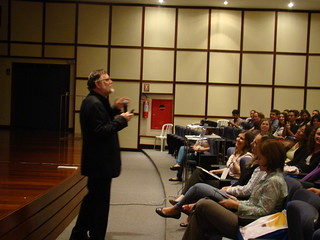
Our CTJ teachers asked; Jeremy Harmer, our inspired and inspiring ELT guest of the month, gave educators some food for thought on various topics related to our field, igniting our professional minds to go above and beyond.
Hello Dani. I am so pleased you
picked up on the ‘door out’ way of thinking about ending lessons. Apart from
the ones I mentioned, we might want to select a student and ask him or her to
summarise what has happened; we might give a period of quiet where students sit
and think about the lessons and then individual students can say anything they
want about what ahs happened in the lesson; we might want to end with a
fantastic video or song; we might end by telling a story which encourages them
to look forward to the next lesson; we might want to….. the list is endless.
The most important thing, it seems to me, is to think carefully about how we
end lessons and then vary the ways we do it. Surprise!

Hi Carlos! There are so many of
them. A teacher at school who believed in me and let me do amazing things that
I wouldn’t have believed possible. A lecturer at university who understood how
to inform but also entertain – and who looked as if he loved what he was doing.
Now? People I read and listen to – my generation includes people like Scott
Thornbury who always enlightens and challenges me - but also a whole tribe of new teachers and
writers from Brazil (I met many of them at BRAZTESOL and CJT) and other
countries who are ‘pushing the boundaries’, challenging us all, have great
energy, new ideas and fresh eyes. I am so lucky to live, partly, in their
world! To learn from people all we have to do, I think is open our ears and our
eyes and start by saying ‘how can I make this work for me?’ rather than ‘That’s
never going to work in my situation!!!

I remember one teacher standing
outside the classroom and throwing in an orange, a book and something else. I
can’t remember what the point of this was, but it got the students’ attention!
How to start a lesson, Selma? Well there are all sorts of warmers and ice breakers,
fund things to do. A story, a game a poem, an information gap activity to lead
into the next stage of the lesson. But I think we need to vary the way we start
lessons so that students have something to look forward to or be curious about.
Sometimes, for example, we will start a lesson in a more formal way, explaining
what we are going to do, or giving information. Sometimes we may go straight
into a teaching sequence. But sometimes we will do something completely
unexpected. Starting lessons – like ending a lesson (see above) – needs to live
somewhere between comforting predictability and unsettling craziness. I guess
it depends on you and the students.

You know what, Patricia, my
greatest challenge was once when I went to Paris (which is very close to London
of course) to speak to French College teachers (secondary teachers). They
didn’t react like anyone else ever and to be honest I don’t think my talk was a
great success! What I learned? First, try to know more about who you will be
with and think how to work with them in an appropriate way; and secondly,
culture does matter, and all teaching and learning takes place in a setting
which is more socially constructed than linguistically focused.
I think it helps, Thiago, if you
love doing it! I love working with teachers. Secondly (and I’m sure about this,
having watched so many teachers with students and presenters etc), it’s all
about passion in a way. If a speaker or teacher has a passion for what they do
(or at least looks as if they have a
passion) it is difficult to resist them! As far as a connection is concerned –
well people are just so interesting. Listen, watch, enjoy – and the connection
is there straight away!

Originally, Vinicius, I didn’t
have a great desire to be a teacher really. I wanted to be a musician, but I
wasn’t good enough :-( But then someone said I could do a short course about
teaching and then I could get a job, maybe in some other country, so I thought
I’d try that. I was incredibly fortunate to find, before that first training
course had ended, that I really enjoyed it, and that the rewards for me, as a
teacher, were likely to be far greater than the negative points. I was inspired
by my trainers – and by the teachers at school who had believed in me and
encouraged me.
Hello Rick…yes I have been
coming to Brazil for years. How quickly time passes…But coming to Brazil has
been an ongoing and repeated joy for me.
What’s changed? Well in Brazil
there’s a confidence and an expertise in the language teaching profession which
is stronger and more exciting than it has ever been – at least if the people I
meet on my visits are anything to go by. There’s an enthusiasm and creativity
among the younger teachers that is incredibly exciting. Part of this is a
desire to examine things in a new way and not accept things just because they
are ‘there’. Of course part of that is driven by the new technologies that have
become part of our educational life. But it’s more than that. It’s a desire to
constantly question and interrogate what we do. That’s what keeps even older
teachers young, I think, and what makes it all worth doing.

That’s a really interesting
question, Clarissa, especially since our students now live in a world where
information about almost anything is instantly available on the Internet, for
example. The challenge is to make coursebooks relevant in that reality, and
really useful. So what we have to do is find ways to train students to learn,
to suggest where they can go next in their learning, and create material that
will help teachers make sense of the chaotic world of learning and
teaching.

My first reaction to your
question, Lilian, is to say that a good teacher can (or should be able to)
teach well with nothing but a stick in the desert. However, we live in a world
in which information technology informs everything we do, one way or another.
And so it would be crazy to ignore that in the socially constructed world of
the classroom. And anyway, technology enhances the learning experience of learning,
can make things more ‘current’ and more ‘real’ – and a lot of English use,
which students need to be comfortable with, around the world is digitally
delivered. We are so lucky to live and teach in the age we do. But (and, to use
an old cliché, it’s a big but) I have a default question I always ask about
technology (or any other teaching innovation) and it is: ‘why is X the best way
to do this?’ If we can’t answer that question satisfactorily then we should use
a way that IS better, even if it doesn’t use technology. Best analogy? The
blackboard. Innovative technology, I bet, when it first appeared. Now
indispensable! But finally: ‘Ask not what we can do for technology, but what
technology can do for us!’

I’m glad you were at that
session in IATEFL, Alba. I enjoyed doing it. I think my point then was (and
still is) that we don’t quite know the best ways to correct people – especially
when you consider that language learners are individuals and each one may
respond differently, and benefit from different correction techniques.
But I think we DO know that
heavy correction during a fluency activity sort of ruins the point of the
activity – although helping students with a more ‘gentle’ variety is almost
certainly helpful for some.
I like the approach that my
brother took when he was teaching at the Wimbledon School of English. He did a
questionnaire and asked all the students how they wanted to be corrected –
because he was worried that he only ever used reformulation, and he wasn’t sure if it worked (neither am I! Do
students REALLY hear the difference between what they say and what we say?)
When he got the results he could then correct in the way the students said they
wanted to be corrected – although interestingly they realized that wasn’t quite
what they wanted once they’d experienced it. So then he changed again. What I
like is that he consulted the students as experts in their own learning, and
the dialogue he had with them was useful and productive.

Hi Inez! I think the job of a
coursebook writer is to provide clear engaging material that will help teachers
and students to learn. The progression needs to be clear, the instruction
rubrics have to be transparent, and both teacher and students need to see the
point of what they are being asked to do.
Of course we try and come up
with enjoyable and interesting topics too, but that depends so much on who the
teachers and students are. It’s up to teachers to make what the coursebook
writer has provided alive and enjoyable. So how to ‘give the teacher a voice’?
Maybe by not putting too much in the book; maybe by leaving metaphorical spaces
between exercises. Maybe by providing lots of suggestions for what can be done;
maybe by offering alternatives at various points; maybe by suggesting how
students and teachers can follow up topics and language material.
Thanks for your kind words about
that plenary in July. I loved being at the CTJ. Lovely place!































